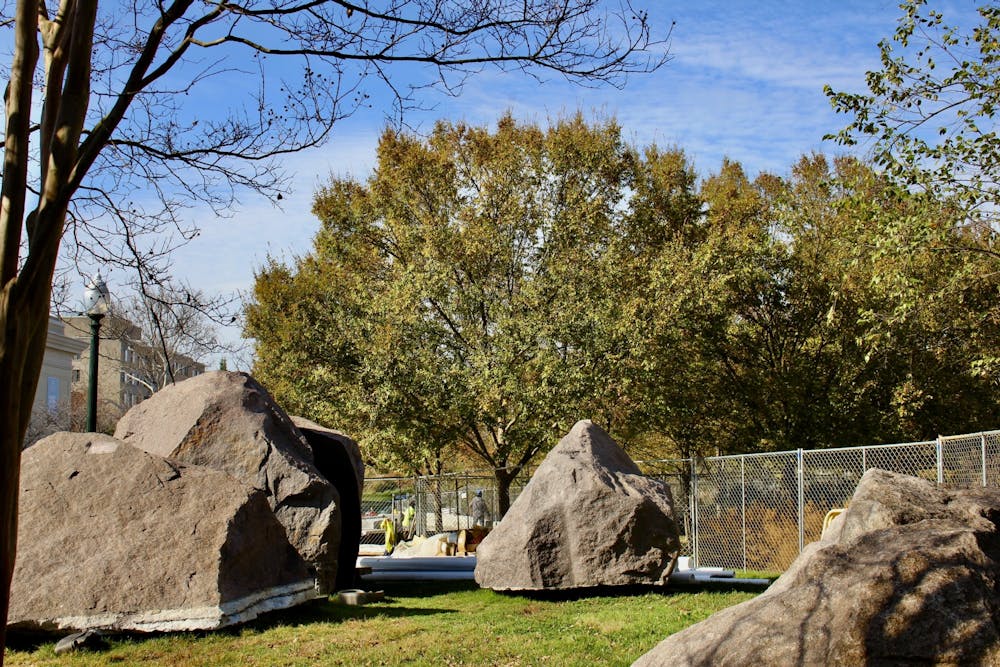From the Newsstands: This story appeared in The Eagle's November 2022 print edition. You can find the digital version here.
In 1981, artist Elyn Zimmerman was commissioned by the National Geographic Society to design a sculpture for the plaza of its D.C. headquarters. More than three decades later, Zimmerman returned to what she thought would be the permanent site to re-imagine her million-pound piece before i is moved nearly four miles to American University’s campus.
Zimmerman coordinated her installation with architect David Childs, who led the earlier renovation of the Society’s headquarters. Zimmerman said it was especially unusual for a relatively young, female artist to be chosen for such a large-scale project.
“I didn’t realize that the piece would become as popular as it was and that it would lead, for me, to a lot of other commissions,” Zimmerman said.
The extent of the sculpture's popularity became evident after its continued existence was threatened. In 2019, National Geographic filed for approval to renovate the plaza of its headquarters. The plans included a new main entry pavilion and a rentable rooftop garden, but no “Marabar.”
Dismantling the purportedly permanent artwork generated significant backlash from the broader artistic community. Museum leaders, architects and art critics sent dozens of complaint letters express- ing their desire that “Marabar” be preserved.
“It made me feel valued and that the work was valued by people who had experience in the art world or architecture,” Zimmerman said.
Public outrage culminated in an organized cam- paign to save the piece, launched by the Cultural Landscape Foundation.
“I was very grateful to the Cultural Landscape Foundation,” Zimmerman said. “They reached out to me and they said ‘Can we help you,’ and I didn’t know how to approach getting this situation remedied.”
National Geographic eventually agreed not todismantle “Marabar'' — committing rather to fund its removal, transportation and installation some- where else. The Society considered Canal Park, lo- cated approximately a block away from the Navy Yard metro station. However, Zimmerman did not think the expansive park landscape was conducive to her piece.
“It was just a big open space, and it didn’t have any context,” Zimmerman said.
After visiting various potential properties, Zimmerman chose a spot across the street from the Katzen Arts Center, where the structure will be visible from Ward Circle. Zimmerman said Canal Park was so open that it felt vulnerable, whereas the smaller and tree-lined site on AU’s campus offered some protection.
In its original iteration, “Marabar” consisted of fractured granite boulders surrounding the perimeter of a 60-foot rectangular reflecting pool. Three of the boulders had polished faces mirroring each other, giving the impression that they were once a single monolithic form. Zimmerman compared her design to geodes — rock structures lined with minerals that are often cut open and polished.
The name “Marabar” originates from fictional caves in E.M. Forster’s “A Passage to India.” Zimmerman said Forster’s description of the caves stuck with her and reminded her of real-world caves she saw during her own visit to India. It was seeing these intricate chambers carved out of solid rock that first inspired Zimmerman to sculpt.
“You discover something, and it sort of sets you off,” Zimmerman said. “I feel like I went to India, I was a painter — I came out of there and all I wanted to do was make stone sculpture.”
“Marabar’s” boulders have already been removed from the plaza at the National Geographic Society. There were safety concerns, both for the relatively fragile polished stones and for whoever was tasked with moving the piece, but Zimmerman said the removal went off brilliantly and referred to the people who performed it as heroes.
Returning to the project after nearly four decades is bittersweet, Zimmerman said. Given its site-specific nature, certain elements of the sculpture’s design will be reconfigured to fit the new location. “Marabar” will be renamed to reflect the changes.
The adapted structure will be titled “Sudama,” after one of the elaborate Indian caves that inspired Forster’s fictionalization. “Sudama” not only pays homage to the original name, but relates to Zim- merman’s own artistic journey.
"The reason I started working with rock and with granite in particular was that I had gone to India in 1976, spent four months there and I visited a number of these sites,” Zimmerman said.
Construction is underway across from Katzen Arts Center to prepare the site for the “Sudama” installation. The installation and landscaping is anticipated to be completed no later than spring 2023, according to University spokesperson Jasmine Pelaez.
“I was very nervous about something possibly going wrong ... things being damaged,” Zimmer- man said. “But I see that the people that are engaged, working on it are very capable and everybody wants the same positive experience at the end.”





